POP!
Viewing Room - SPRING 2025
Step into the world of POP!
We are thrilled to present an esteemed collection of 15 coveted works by the masters of Pop Art, including Andy Warhol, Keith Haring, and Robert Indiana. Spanning the movement’s most iconic moments, these works embody the bold, rebellious energy that made Pop Art a cultural revolution.
Big, bold, and totally unforgettable! Pop Art emerged in the late 1950s, transforming advertising, TV, film, and mass media into high art. It blurred the lines between art and life, high and low culture, creating some of the most recognizable imagery of the 20th century.
From pioneers to today’s visionaries—this collection highlights the enduring legacy of Pop Art, from its early icons to Neo Pop expressions by artists like Alex Katz, KAWS, and Jeff Koons. Their work proves that Pop’s electric energy continues to shape the art world today.
Want to dive deeper? Read Pop Art: Themes, Styles, and Its Enduring Influence.
Scroll down to explore this extraordinary collection!
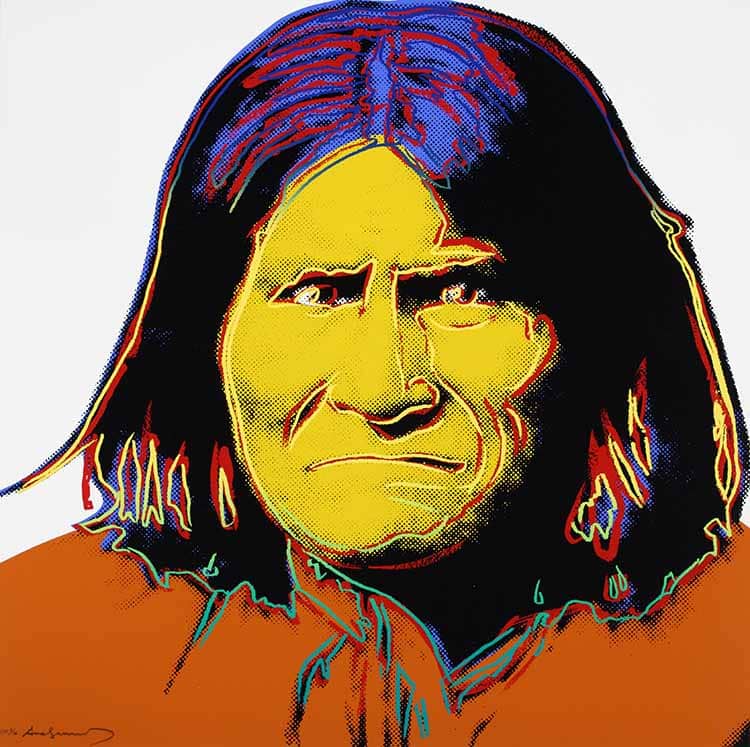
Geronimo, from Cowboys and Indians (F&S II.384), 1986
Geronimo, from Cowboys and Indians (F&S II.384), 1986
in
cm
$109,000
plus shipping & taxes
About the work
Geronimo is part of Warhol’s Cowboys and Indians series, a striking screenprint three feet square that confronts the viewer with the bold gaze of its subject, the Apache leader and medicine man bearing the titular name. The print transforms a photograph taken by Ben Wittick, cropping it to a bust rendered in fiery orange, red, and yellow. As with the other works in this series, Geronimo was Warhol’s effort to investigate how the media constructed Native American history. The figure was as powerful in life as he appears in print, resisting the displacement of his people before being captured and imprisoned.
Pencil signed and numbered.
Andy Warhol
Andy Warhol remains one of the most enigmatic and transformative figures in American art. His work became a defining expression of a culture preoccupied with images, fame, and consumerism. Surrounded by a colourful entourage of bohemians with names like Viva, Candy Darling, and Ultra Violet, Warhol’s social life was legendary and he was also recognized for his unrelenting work ethic. His art blurred the lines between high and low culture, while his films became milestones in experimental art and the evolution of contemporary art films. In his later years, Warhol was often seen wandering New York’s affluent neighbourhoods with a plastic bag full of hundred-dollar bills, buying jewellery and trinkets. Andy Warhol forever changed the way the world views art.
Born Andrew Warhola on August 6, 1928, in Pittsburgh, Warhol studied at the Carnegie Institute of Technology, earning his B.F.A. in 1949. That same year, he moved to New York City, where he quickly gained success as a commercial artist and illustrator. Throughout the 1950s, his drawings were featured in Glamour and other magazines, as well as department store displays. He became especially well-known for his illustrations of I. Miller shoes. In 1952, the Hugo Gallery in New York exhibited his illustrations for Truman Capote’s writings, further establishing his reputation.
During this period, Warhol also began exploring a separate body of work that he considered his serious artistic pursuit. While these paintings maintained stylistic elements of advertising, they sought to do the opposite of selling. His iconic series of Campbell’s Soup Cans, along with works featuring Coca-Cola bottles, Superman comics, and other familiar images, examined society’s fixation on consumer goods. Unlike advertisements, which aimed to evoke unconscious desire, Warhol’s art invited viewers to pause and reflect on the oversaturated imagery surrounding them. This approach aligned him with other artists of the Pop Art movement, such as Jasper Johns, Roy Lichtenstein, and Robert Rauschenberg.
In the late 1950s and throughout the 1960s, Warhol worked at an astonishing pace, adopting production methods that mirrored the industries he critiqued. He dubbed his studio “The Factory,” which became both a hub for creating paintings, silkscreens, and sculptures, and a gathering place for New York’s vibrant cultural elite. Frequent visitors included Mick Jagger, Lou Reed, Martha Graham, and Truman Capote. Warhol’s fascination with fame, youth, and personality transformed him into a cultural icon in his own right, reflecting the desires of a consumer-driven American society. His famous observation that “everyone will be world-famous for fifteen minutes” captured the growing commodification of everyday life with striking accuracy.
By the mid-1960s, Warhol was one of the most renowned artists in the world. Critics often struggled to interpret his groundbreaking work, which aimed to make viewers linger on images longer than they ordinarily would. In the 1970s and 1980s, Warhol created hundreds of silkscreen portraits, depicting figures such as Liza Minnelli, Jimmy Carter, Elizabeth Taylor, and Albert Einstein. These works revealed a more nuanced and expressionistic side of his artistry.
Andy Warhol passed away on February 22, 1987. His legacy endures as a cornerstone of contemporary art, reshaping how we understand fame, consumerism, and the role of art in modern society.
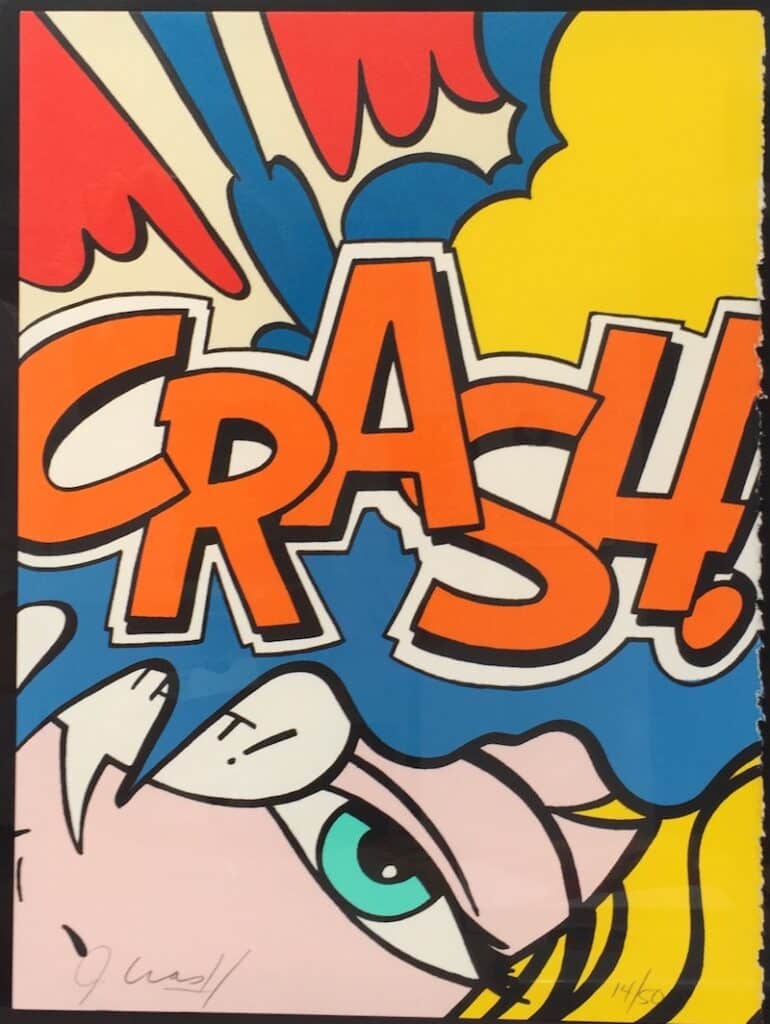
Crash Orange, 1989
Crash Orange, 1989
in
cm
$3,700
plus shipping & taxes
About the work
The instantly recognizable Pop Art approach of Crash, Orange captures attention in much the same way its namesake event would. Unable to look away, the viewer is rubbernecked into admiring the flat, vibrant colour palette that harkens back to comic books of old and influences such as Roy Lichtenstein. A wide, turquoise eye peers out from below the loud word—”CRASH!”—splashed across the front of the largely abstract scene, the woman’s objection obscured behind a burst of primary blue. Next to the ostensibly careless tear of the page, her waterfall of yellow hair is echoed above in cloud-like bursts that spark curiosity: what could have caused this explosive event? The close crop of the image, however, leaves the viewer to imagine what chaos is ensuring beyond the paper’s perimeter.
Pencil signed and numbered.
John Matos, aka CRASH
John Matos, widely known by his artist name CRASH, is a graffiti artist from New York City and a key figure in the Graffiti art movement. Raised in the Bronx, CRASH began tagging and spraying at just 13 years old, following older teens from his neighbourhood to the train yards. His artistic journey began there, and his name soon became synonymous with New York City’s graffiti scene.
He adopted the name “CRASH” after accidentally crashing a school computer, a name that would later appear on subway cars and dilapidated buildings across the city. Initially gaining recognition through his vibrant murals on subway trains, CRASH is now celebrated as a pioneer of graffiti art, helping to establish it as a legitimate art form.
In 1980, CRASH curated the groundbreaking exhibition Graffiti Art Success for America at Fashion MODA, a pivotal moment that propelled graffiti into mainstream art conversations and cemented its cultural significance. Since then, he has participated in numerous high-profile art projects. In 1995, CRASH was commissioned by British American Tobacco to create work for their Lucky Strike brand, joining the ranks of artists like Keith Haring. The following year, he designed an Eric Clapton Signature Stratocaster, presenting it to the musician as a gift. Over the years, CRASH has created five guitars for Clapton. In 2010, he collaborated with Sanrio to produce a series of Hello Kitty-inspired paintings, which were exhibited at Art Basel Miami Beach.
CRASH’s influence extends beyond the graffiti community, with his work featured in museum and gallery exhibitions worldwide and included in permanent collections. Known for his visually iconic style, he has partnered with renowned companies such as Absolut Vodka, Fender Guitars, Levi’s, SoBella Handbags, and Sanrio for various projects.
Continuing to create and exhibit his art locally and internationally, CRASH remains a driving force in the Graffiti art movement, pushing its boundaries while staying true to its roots.
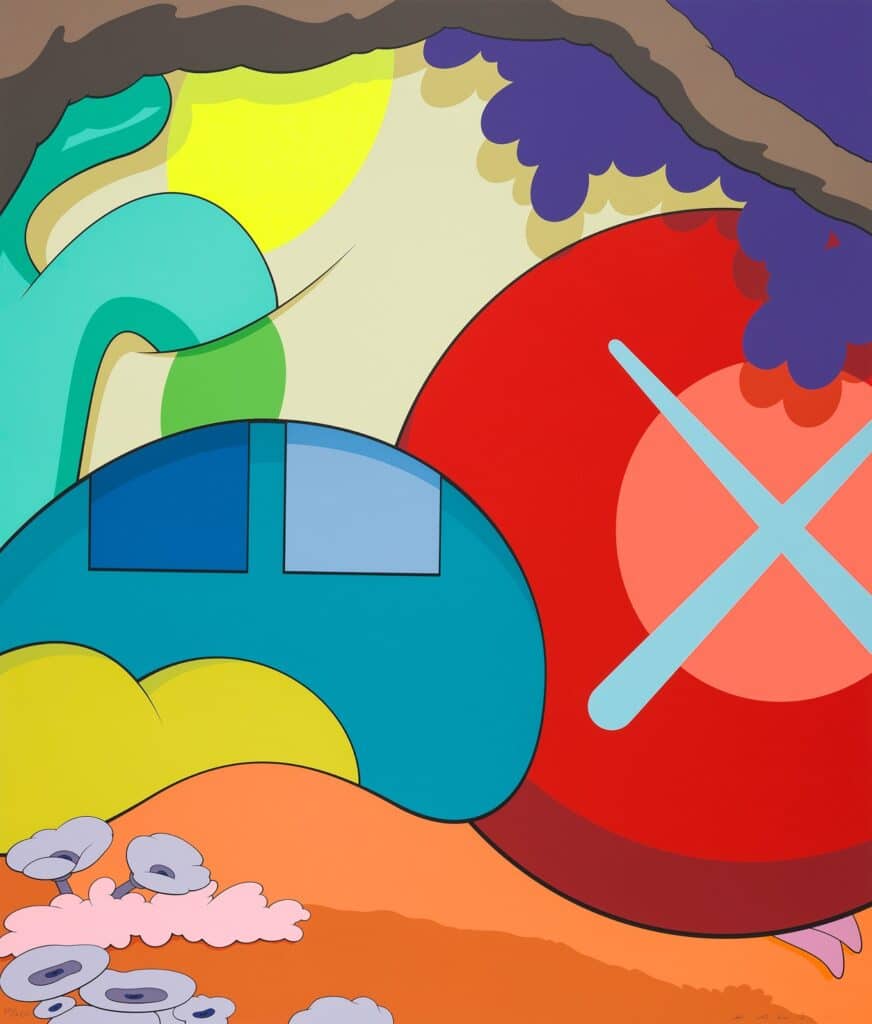
You Should Know I Know, 2015
You Should Know I Know, 2015
in
cm
$51,000
plus shipping & taxes
About the work
Featuring the iconic “X” and cartoon style for which the Brooklyn street artist KAWS is known, You Should Know I Know is a vibrant, engaging work that seizes the viewer’s attention and refuses to let go. The eye darts from the bold red circle shaded by a purple tree above to incongruently flat shapes in the background and again to the undulating curves and organic additions in the foreground. Like a landscape from a fever dream, this colourful screenprint seems to promise adventure to the viewer brave enough to venture in and also sparks caution in the face of such an unfamiliar environment.
Pencil signed and numbered.
KAWS
Brian Donnelly (born 1974), professionally known as Kaws (stylized as KAWS), is an American artist and designer whose work spans a variety of media. He is widely recognized for his recurring use of figurative characters and motifs, many of which originated in the 1990s. Initially created as 2D paintings, these characters have since been brought to life in 3D forms. Some of these figures are original creations, while others are reinterpretations of familiar icons.
Kaws’ sculptures vary greatly in size, from a few inches to towering installations as tall as ten metres. They are crafted from a range of materials, including fibreglass, aluminium, wood, bronze, and even steel pontoon inflatable rafts. His distinctive style and innovative approach have made his work highly sought after in the art world.
His creations have been exhibited in galleries and museums worldwide, are part of the permanent collections of public institutions, and are prized by private collectors. Notable admirers of his work include music producer Swizz Beatz, rapper Pharrell Williams, and internet personality PewDiePie. Numerous books showcasing Kaws’ artistic achievements have also been published.
Based in Brooklyn, New York, Kaws produces sculptures, acrylic paintings on canvas, and screen prints. In addition to his gallery and museum work, he is known for his commercial collaborations. These partnerships have included limited-edition toys, as well as clothing, skate decks, and other products. His ability to merge fine art with commercial appeal has solidified his status as one of the most versatile and influential artists of his generation.
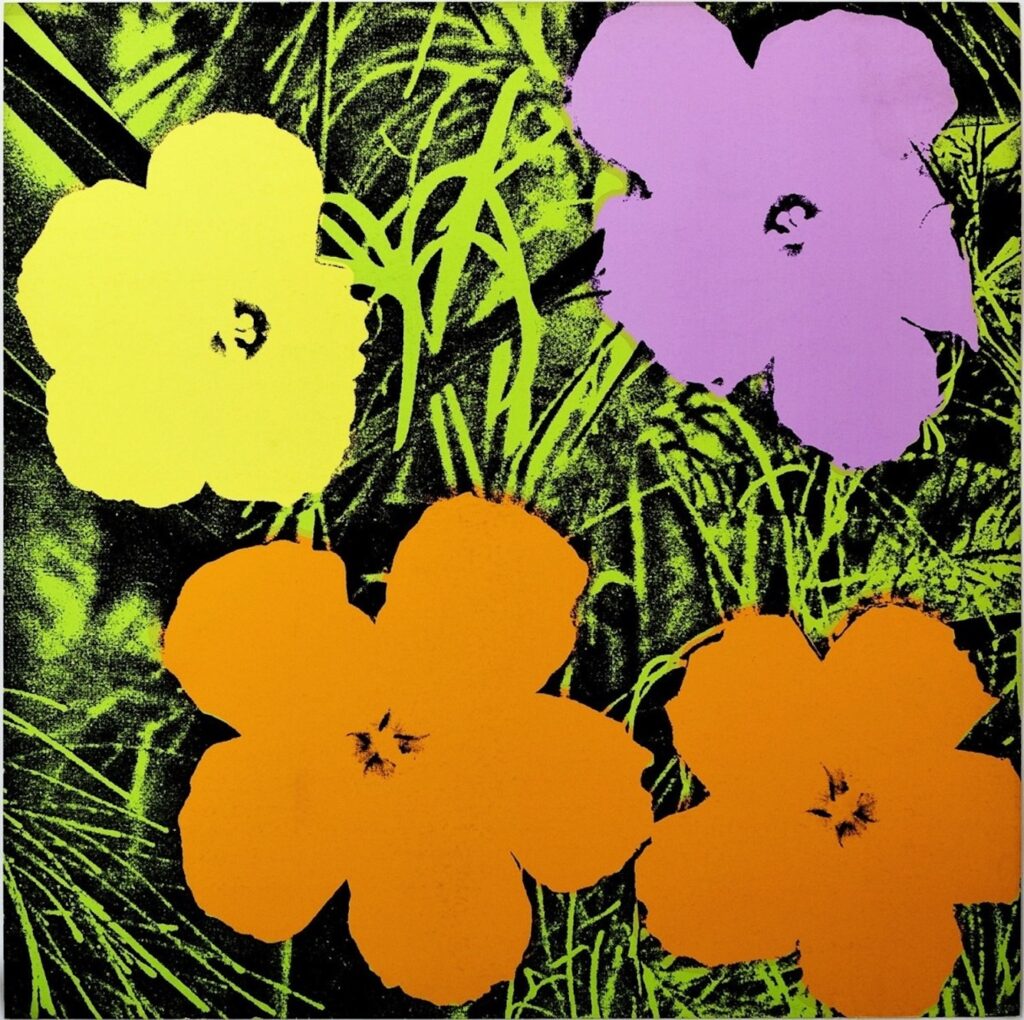
Flowers (F&S II.67), 1970
Flowers (F&S II.67), 1970
in
cm
$180,000
plus shipping & taxes
About the work
Perhaps some of the most recognizable Warhol images — in addition to Campbell’s Soup cans and Marilyn Monroe portraits —are his iconic screenprinted Flowers. The artist first explored this floral image in the mid-1960s, exhibiting Flowers at New York’s Leo Castelli Gallery in 1964. Though the joyful hibiscus flower might appear to be an abrupt departure from Warhol’s more common critiques of art and consumerism, Flowers is intended to explore the relationship between nature and the commercialization of society. Here, saturated yellow, orange, and purple flowers pop on a background reminiscent of a photocopied photograph of grass – flattened and flattened again. Its large size (three feet square) draws the viewer into a radiant world of artifice where grass and petals are made graphic and stylized. Flowers, symbols of the beauty of nature – envelop the viewer and melt the distinction between nature and human production.
Signed, stamped, and numbered on verso.
Andy Warhol
Andy Warhol remains one of the most enigmatic and transformative figures in American art. His work became a defining expression of a culture preoccupied with images, fame, and consumerism. Surrounded by a colourful entourage of bohemians with names like Viva, Candy Darling, and Ultra Violet, Warhol’s social life was legendary and he was also recognized for his unrelenting work ethic. His art blurred the lines between high and low culture, while his films became milestones in experimental art and the evolution of contemporary art films. In his later years, Warhol was often seen wandering New York’s affluent neighbourhoods with a plastic bag full of hundred-dollar bills, buying jewellery and trinkets. Andy Warhol forever changed the way the world views art.
Born Andrew Warhola on August 6, 1928, in Pittsburgh, Warhol studied at the Carnegie Institute of Technology, earning his B.F.A. in 1949. That same year, he moved to New York City, where he quickly gained success as a commercial artist and illustrator. Throughout the 1950s, his drawings were featured in Glamour and other magazines, as well as department store displays. He became especially well-known for his illustrations of I. Miller shoes. In 1952, the Hugo Gallery in New York exhibited his illustrations for Truman Capote’s writings, further establishing his reputation.
During this period, Warhol also began exploring a separate body of work that he considered his serious artistic pursuit. While these paintings maintained stylistic elements of advertising, they sought to do the opposite of selling. His iconic series of Campbell’s Soup Cans, along with works featuring Coca-Cola bottles, Superman comics, and other familiar images, examined society’s fixation on consumer goods. Unlike advertisements, which aimed to evoke unconscious desire, Warhol’s art invited viewers to pause and reflect on the oversaturated imagery surrounding them. This approach aligned him with other artists of the Pop Art movement, such as Jasper Johns, Roy Lichtenstein, and Robert Rauschenberg.
In the late 1950s and throughout the 1960s, Warhol worked at an astonishing pace, adopting production methods that mirrored the industries he critiqued. He dubbed his studio “The Factory,” which became both a hub for creating paintings, silkscreens, and sculptures, and a gathering place for New York’s vibrant cultural elite. Frequent visitors included Mick Jagger, Lou Reed, Martha Graham, and Truman Capote. Warhol’s fascination with fame, youth, and personality transformed him into a cultural icon in his own right, reflecting the desires of a consumer-driven American society. His famous observation that “everyone will be world-famous for fifteen minutes” captured the growing commodification of everyday life with striking accuracy.
By the mid-1960s, Warhol was one of the most renowned artists in the world. Critics often struggled to interpret his groundbreaking work, which aimed to make viewers linger on images longer than they ordinarily would. In the 1970s and 1980s, Warhol created hundreds of silkscreen portraits, depicting figures such as Liza Minnelli, Jimmy Carter, Elizabeth Taylor, and Albert Einstein. These works revealed a more nuanced and expressionistic side of his artistry.
Andy Warhol passed away on February 22, 1987. His legacy endures as a cornerstone of contemporary art, reshaping how we understand fame, consumerism, and the role of art in modern society.
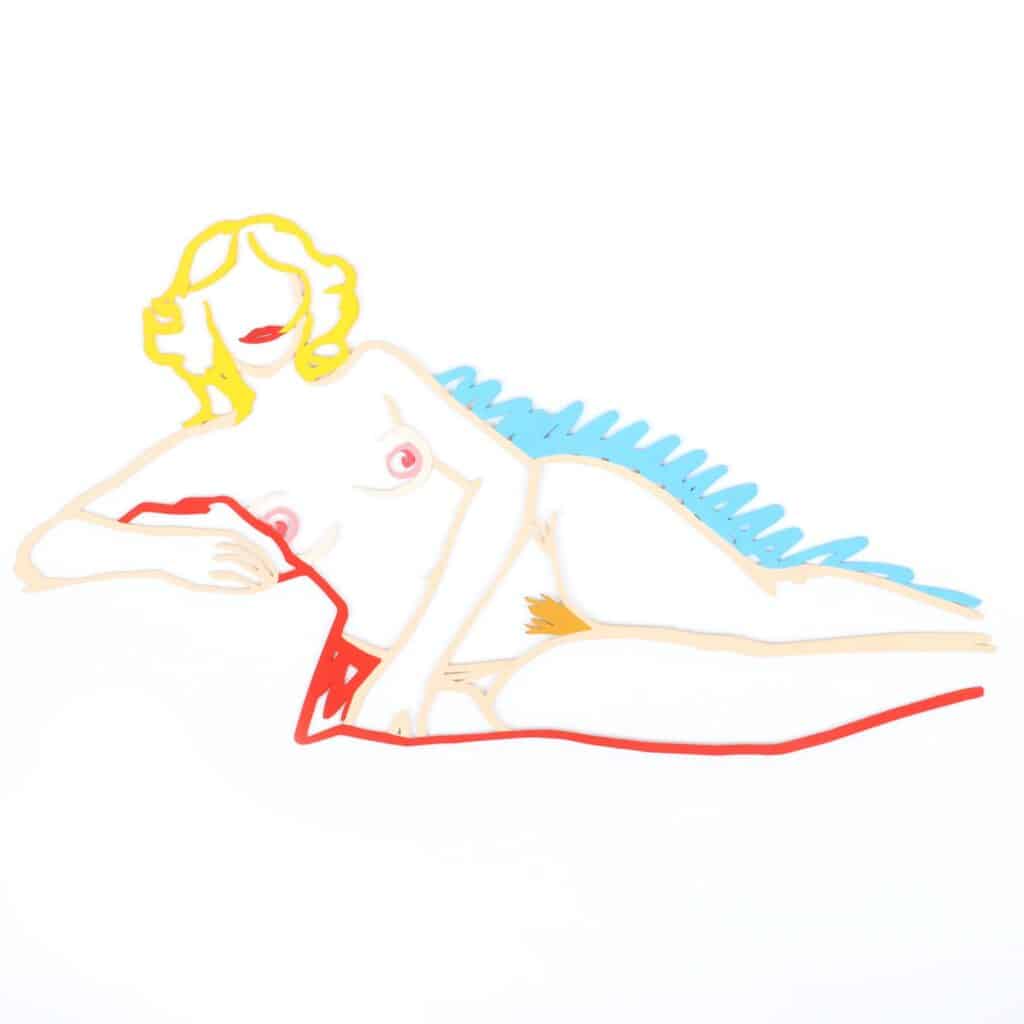
Rosemary Lying on One Elbow, 1989
Rosemary Lying on One Elbow, 1989
in
cm
$61,000
plus shipping & taxes
About the work
In his steelcuts such as Rosemary Lying on One Elbow, Pop artist Tom Wesselmann brings his vibrant paintings into a fresh medium. The artist pioneered this process in the late 1960s—Rosemary was created by cutting, shaping, and welding steel sheets. Many of his works from this period explore the nude female form, and this particular piece is rendered in striking colour, her hair in bold yellow, her lips and the chaise on which she lays outlined in striking red. A scribble of light blue implies a shadow behind the reclined figure transforming the classical reclining nude into a distinctly modern representation in the Pop idiom.
Signed, titled, dated, and numbered on verso.
Tom Wesselmann
Tom Wesselmann (born 1931) began his artistic studies in his hometown of Cincinnati before continuing at Cooper Union in New York. During his time at Cooper Union, he was heavily influenced by Abstract Expressionism, particularly the works of Willem de Kooning and Jackson Pollock. However, he eventually rejected this style, believing it had become overly introspective, leaving little space for further creative innovation.
This shift led Wesselmann toward Pop Art, a stark contrast to the emotional complexities of action painting. In this new approach, he adopted a tightly controlled style and focused on mundane subject matter. Alongside artists like Andy Warhol and Wayne Thiebaud, Wesselmann championed the idea that everyday objects held intrinsic significance, worthy of artistic depiction because of their shared familiarity. His contributions were integral to the launch of the Pop Art movement, as he was one of the artists involved in the creation of its foundational portfolios.
In 1959, Wesselmann began experimenting with small abstract collages, and by 1960, he incorporated advertising imagery to produce vibrant still lifes, interiors, and assemblages. His work often featured commonplace household items and highly stylized depictions of the female nude. By the late 1960s, his art took on a more pronounced eroticism, characterized by vivid colours, precise compositions, and exaggerated, flowing forms. In the 1970s, his works grew significantly larger in scale, with enormous still lifes evolving into partially free-standing sculptures and, eventually, into fully realized sculptures made from sheet metal. During the 1980s, he returned to wall-mounted works, creating intricate steel and aluminum cut-outs.
Wesselmann pioneered several innovative techniques, including his “drop outs,” where negative spaces transform into positive shapes, and his “cut outs,” which use laser-cut metal to create striking three-dimensional drawings. He was also a skilled printmaker, producing bold, large-scale silkscreens and lithographs that further expanded his artistic repertoire.
His work is featured in many of the world’s most prominent museums, including the Museum of Modern Art and the Whitney Museum in New York, the Hirshhorn Museum in Washington D.C., the Walker Art Center and Minneapolis Institute of Fine Arts in Minneapolis, the Philadelphia Museum of Art, and the Dallas Museum of Fine Arts, among others. Wesselmann’s art is also represented in major institutions in Germany, France, and Denmark, underscoring his global influence and enduring legacy.
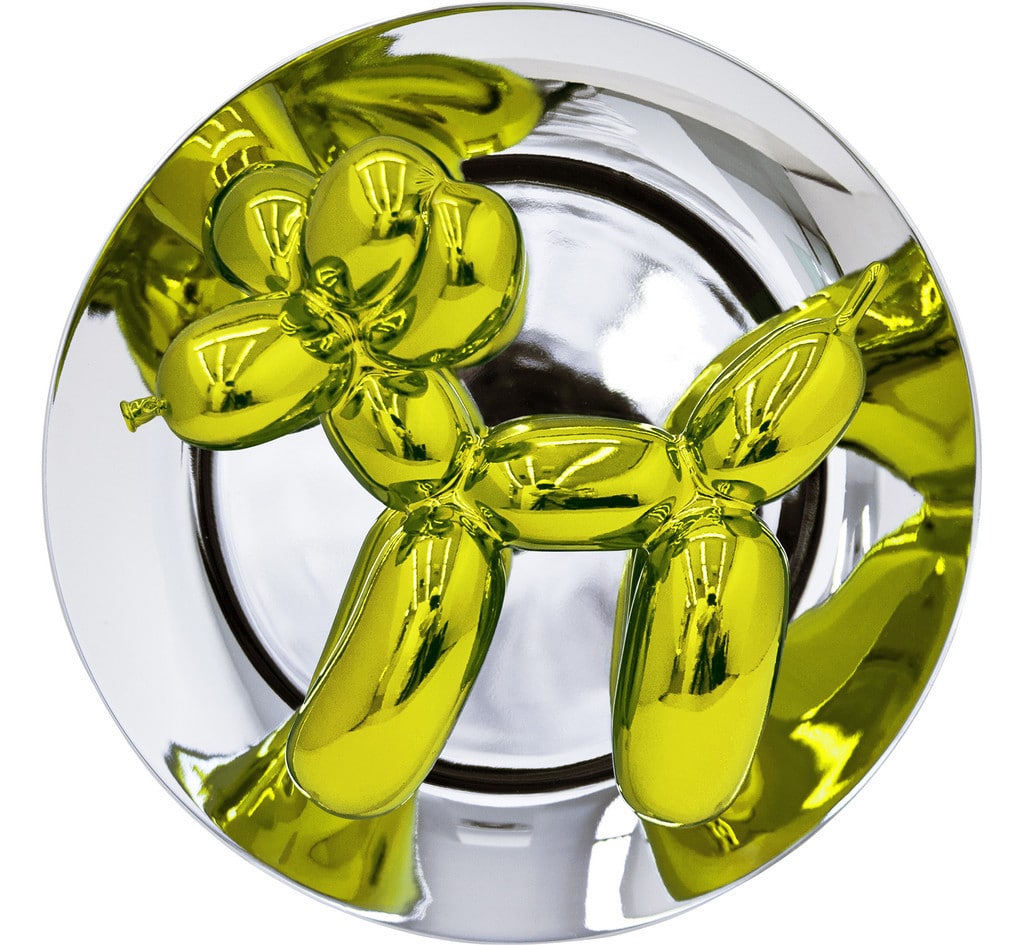
Balloon Dog (Yellow), 2015
Balloon Dog (Yellow), 2015
in
cm
$14,000
plus shipping & taxes
About the work
The monumental Balloon Dog is one of Jeff Koons’ most iconic creations and this metallic porcelain version is an excellent domestic-sized option for the avid collector. Both literal and abstract, Balloon Dog (Yellow) combines ovoid shapes into a recognizable figure even while the glossy surface distorts reflections and bends the light. Aloof and nostalgic, it’s little wonder this image has held the attention of the public for decades since it was first adopted by Koons in 1994. In true Koons style, this piece from his Celebration series, is a nod to childhood and simplicity whilst elevating a the common pet to become an icon of American popular culture. “Balloon Dog is a very optimistic piece…But at the same time there’s the profoundness of an archaic sculpture. The piece has an interior life while the reflective exterior surface affirms the viewer through their reflection.” — Jeff Koons
Signed and numbered on verso.
Jeff Koons
Jeff Koons was born in York, Pennsylvania, in 1955. At the age of eight, he painted copies of Old Master paintings, signed them “Jeffrey Koons,” and sold them at his father’s furniture store. In 1972, he attended the Maryland Institute College of Art in Baltimore. After an exchange year at the Art Institute of Chicago, he graduated with a BFA in 1976. In 1977, he moved to New York and began working at the membership desk of the Museum of Modern Art. There he quickly became notorious for his outrageous clothes and hair, as well as his impressive salesmanship. It was during this period that he first began to work with garish inflatable flowers and rabbits, combining them with plastic, Plexiglas, and mirrors to produce striking sculptures. In 1980, Koons left the museum and began selling mutual funds and stocks at First Investors Corporation to finance the work that would eventually appear in his The New series (1980–83): vacuum cleaners and shampoo polishers displayed in clear Plexiglas vitrines.
Koons’s Equilibrium series (1985) included sculptures comprised of basketballs floating in tanks of water. In 1986, he appeared in a group show with Peter Halley, Ashley Bickerton, and Meyer Vaisman at Sonnabend Gallery in New York; the cool style of the works in the show led critics to declare a shift away from the Neo-Expressionism that had dominated the earlier half of the decade. Koons’s Rabbit (1986), a forty-one-inch-high stainless-steel version of one of the inflatable rabbits he had experimented with previously, drew much of the critical attention. During that same year, Koons introduced the subject of consumerist decadence in his work, most notably in the series Luxury and Degradation, which features images of liquor advertisements and sculptural renderings of travel bars (liquor bottles and glasses in portable cases). He expanded on this theme in the Banality series (1988), producing sculptural pairings such as the pop singer Michael Jackson and his pet chimpanzee (in Michael Jackson and Bubbles). This series also included “ads,” starring Koons himself, that played on his newfound art-world celebrity. This use of his own image presaged the Made in Heaven series (1990–91), first shown at the 1990 Venice Biennale, in which the artist and his new wife, Ilona Staller, appeared in a panoply of hard-core pornographic poses.
In 1992, Koons’s forty-foot-high sculpture Puppy, a rendering of a West Highland terrier comprised of soil and living, multicolored flowers, was installed in Kassel during Documenta 9. Though not part of the official show, the sculpture was extremely popular and has since been displayed in other cities, including New York, Sydney, and Bilbao. In his work since the mid-1990s—in series such as Celebration (1995–98), Easyfun (1999–2000), Easyfun/Ethereal (2000–02), Popeye (2003), and Hulk Elvis (2007), Koons has continued to produce sculpture but has also concentrated on complex paintings that oscillate between abstraction and pop-culture references.
Koons has had numerous solo exhibitions since a 1980 window installation at the New Museum of Contemporary Art in New York, including shows at the Museum of Contemporary Art in Chicago (1988 and 2008), Walker Art Center in Minneapolis (1993), Museum of Contemporary Art in Sydney (1995), Guggenheim Museum Bilbao (1997), Deutsche Guggenheim Berlin (2000), Museo Archeologico Nazionale di Napoli (2003), Victoria and Albert Museum in London (2006), Metropolitan Museum of Art in New York (2008), and Neue Nationalgalerie in Berlin (2008). He has also exhibited widely in international group exhibitions, such as Lighting at P.S. 1 in New York (1981), Skulptur. Projekte in Münster (1987), Whitney Biennial (1987 and 1989), Carnegie International (1988), Biennale of Sydney (1990), Venice Biennale (1990 and 1997), American Art in the Twentieth Century at the Royal Academy of Arts in London (1993), Hypermental at Kunsthaus Zürich (2000), Art 36 Basel (2005), and Art in America organized by the Solomon R. Guggenheim Musum and presented at the Museum of Contemporary Art in Shanghai (2007). He received the BZ Cultural Award from the City of Berlin in 2000 and the Skowhegan Medal for Sculpture in 2001. He was named a Chevalier of the French Legion of Honor in 2002 and then promoted to Officier in 2007, and was given the Wollaston Award from the Royal Academy of Arts in London (2008). He lives and works in New York City and York, Pennsylvania.
Source: Guggenheim Museum
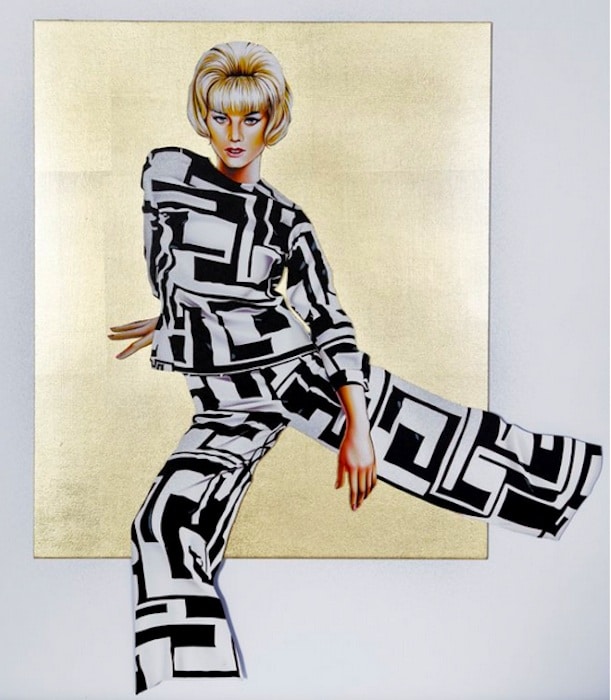
Pucci Pants, 2015
Pucci Pants, 2015
in
cm
$11,000
plus shipping & taxes
About the work
Seductively posed in designer Emilio Pucci’s signature printed pant, Mel Ramos’ sultry female figure initiates bold eye contact. Like much of Ramos’ work, this lithograph plays to mass media and popular culture, evoking wealth and luxury with its shimmering gold leaf base and the expensive attire and flawless makeup of the pin-up-esque subject. The realism of the foreground is juxtaposed against an abstract and mostly blank backdrop, and the viewer is held firmly within the frame, with no hint of the event prompting the immortalization of the floating model.
Presented in its original box and accompanied by a certificate of authenticity. Signed and numbered by the artist.
Mel Ramos
Mel Ramos was a California-based artist who first gained significant recognition in the early 1960s. Alongside contemporaries such as Andy Warhol, Roy Lichtenstein, Claes Oldenburg, and James Rosenquist, Ramos created artworks that celebrated popular culture as depicted in mass media.
Deeply influenced by his teacher, Wayne Thiebaud, Ramos developed a distinct style within the Pop Art movement. His work merges images of nude pin-up models from American magazines and advertisements with branded consumer products, offering a critical and ironic commentary on the clichés perpetuated by media advertising.
In 1967, Ramos held a notable exhibition at the San Francisco Museum of Modern Art, which led to numerous shows across the United States and Europe. In 1972, his work was included in the landmark Pop Art exhibition at the Whitney Museum in New York, further solidifying his place within the movement.
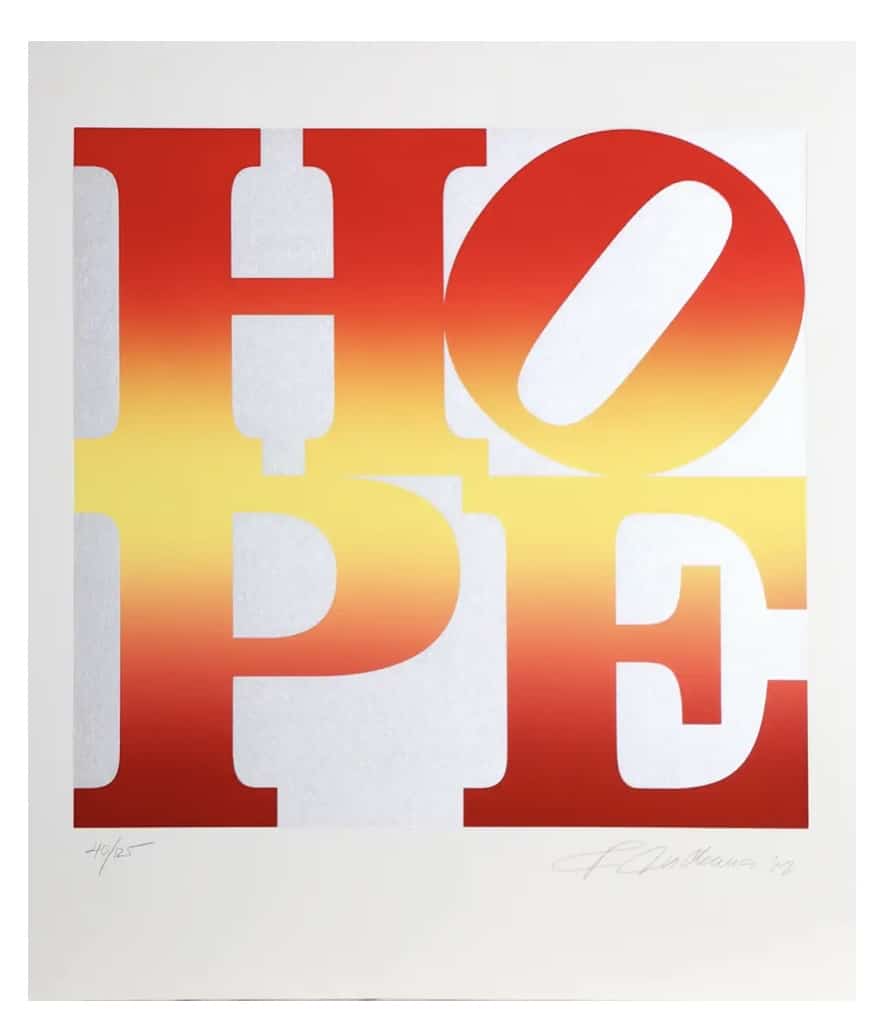
Four Seasons of Hope, Autumn, 2012
Four Seasons of Hope, Autumn, 2012
in
cm
$15,000
plus shipping & taxes
About the work
This striking silkscreen is reminiscent of Robert Indiana’s LOVE sculpture that exemplified 1960s movements and endured far beyond that decade. The Four Seasons of Hope series features this iconic design—also rendered in sculpture form, currently residing near Times Square in NYC—in four seasonal colour combinations. Autumn bursts from the canvas in bold reds and yellows, the stylization of the text upholding the artist’s goal of presenting words everyone knows in unexpected ways, giving them more weight and emotion and inviting the viewer to think about what “hope” means to them.
Pencil signed and numbered.
Robert Indiana
Robert Indiana holds a unique place in contemporary art. He transformed the everyday symbols of roadside America into vibrant, geometric pop art, using his work as both cultural commentary and, during the rebellious 1960s, a platform for sharp political statements.
Born Robert Clark in New Castle, Indiana, in 1928, he adopted the name of his home state as his professional surname early in his career. Indiana’s creations, which he called “sculptural poems,” are marked by bold, simple imagery featuring numbers and short words such as “EAT,” “HUG,” and “LOVE.” Unlike many of his Pop Art contemporaries who drew heavily from mass media imagery, Indiana used words to explore themes of identity. Rendered in vivid colours and bold block letters, these words invite viewers to reconsider the commonplace from a fresh perspective.
Although Indiana’s methods are distinct, his work firmly situates him within the Pop Art movement. Like Andy Warhol, who reproduced images of celebrities and consumer goods, Indiana offers a direct and unvarnished reflection of American culture while maintaining an air of detachment. His most iconic series features familiar words—typically three to five letters long—repeated, mirrored, or divided. Their simplicity and flat presentation exemplify Pop Art’s accessibility, allowing viewers to engage with his work on an immediate level without searching for deeper meanings.
What sets Indiana apart from his Pop Art peers, however, is the depth of his personal connection to his subject matter. His works engage with significant forces shaping American culture in the latter half of the 20th century: personal and national identity, political and social turmoil, the rise of consumerism, and the weight of historical legacy. Through his art, Indiana both critiques and celebrates the American way of life, challenging viewers to reflect on their own perceptions.
By presenting familiar words in unconventional ways, Indiana encourages audiences to reevaluate the assumptions and emotions tied to these words. For instance, the word “EAT” transcends its literal meaning to evoke broader social and cultural connotations. It may remind viewers of intimacy and the role of food in family, community, and romantic traditions, while also critiquing societal issues like unhealthy diets in consumer-driven culture.
Indiana’s most famous work, the LOVE sculpture of 1966, exemplifies this approach. Featuring bold block letters in bright colours and dividing the word into two parts, Indiana transforms “LOVE” into something unfamiliar, urging viewers to contemplate its personal significance. His exploration of “LOVE” extended into themes of complex relationships and spirituality, making the work a deeply introspective examination of a universal concept.
Robert Indiana’s art challenges viewers to see the ordinary anew, blending cultural critique with personal reflection. Through his iconic works, he captures the complexities of modern life, leaving an enduring legacy in both Pop Art and American culture.
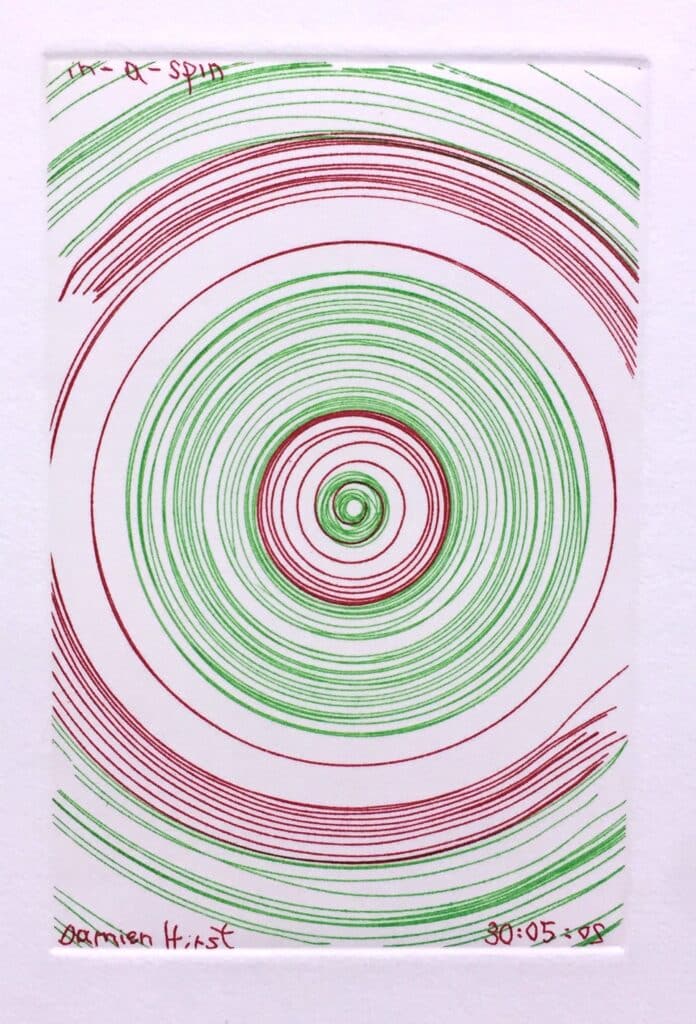
In a Spin, from In a Spin, the Action of the World on Things, 2002
In a Spin, from In a Spin, the Action of the World on Things, 2002
in
cm
$5,900
plus shipping & taxes
About the work
From his earliest days as part of the Young British Artists group, Damien Hirst has been creating controversial works. Though less overt than some of his pieces, the underlying themes of mortality and decay remain in Hirst’s In a Spin. The series takes a conceptual tact, again a common Hirst theme, continuing the artistic approach he began in the 1990s with abstracts made by pouring paint onto spinning canvases. This spin etching version attached copper plates to the spin machine instead, then used needles, screwdrivers, and other tools to “draw” on them in a process that took days for each plate. Hirst was reportedly inspired by long-exposure photographs of the night sky.
Signed in pencil.
Damien Hirst
Damien Hirst is one of the most influential artists of his generation, known for creating works that are instantly recognizable. From the shark suspended in formaldehyde in The Physical Impossibility of Death in the Mind of Someone Living to his spot, spin, and butterfly paintings, and later works like the diamond-encrusted skull For the Love of God, Hirst has produced art that continues to captivate and challenge audiences.
Hirst’s work delves deeply into contemporary belief systems, exploring the tensions and uncertainties that underpin the human experience. With a direct approach to themes of existence, he examines the intricate connections between life, death, religion, and art. His pieces push viewers to confront their perceptions, questioning the boundaries between fear and desire, faith and reason, and love and hate.
Blurring the lines between science, religion, and art, Hirst incorporates scientific tools and religious iconography to evoke both the terror of immortality and the stark beauty of reality. Death is a recurring theme in his work, compelling viewers to face the inevitability of existence. Among his most famous creations are a series of artworks featuring preserved dead animals, such as sharks, sheep, and cows, displayed in formaldehyde. The most iconic of these is the 14-foot tiger shark preserved in The Physical Impossibility of Death in the Mind of Someone Living, a work that embodies astonishment and existential inquiry.
In 2008, Hirst made history by bypassing his long-standing galleries to sell an entire show, Beautiful Inside My Head Forever, through an auction at Sotheby’s. The auction shattered expectations, raising $198 million and setting a record for a one-artist auction.
Since 1987, Hirst has had over 80 solo exhibitions around the world, with his work featured in more than 260 group shows. In 2012, his immense contributions to contemporary art were celebrated with a major retrospective at the Tate Modern, marking over 25 years of groundbreaking creativity. Hirst’s work continues to resonate, challenging and inspiring audiences globally.
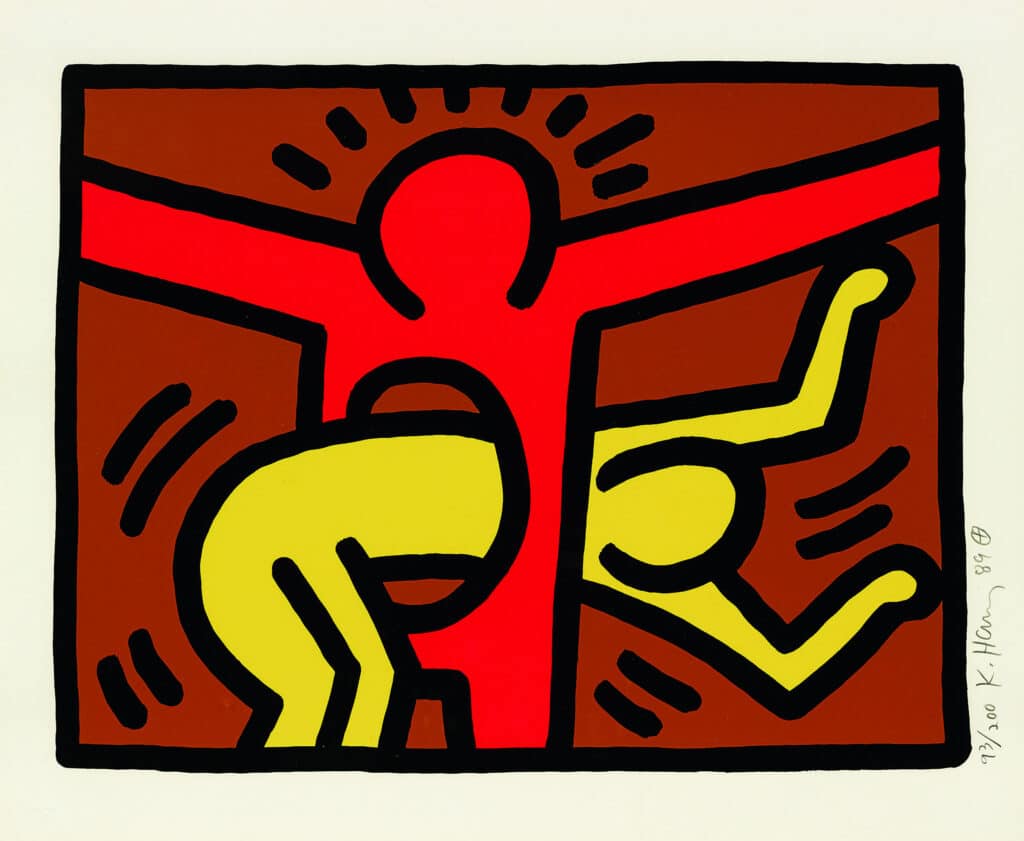
Pop Shop IV (C), 1989
Pop Shop IV (C), 1989
in
cm
$65,500
plus shipping & taxes
About the work
This emphatic silkscreen print is rendered in Keith Haring’s instantly recognizable Neo Pop style. Implying and highlighting motion through bold black dashes, Haring clearly communicates to his viewers the movement of his characters, one red and one yellow, who interact in the most intimate way possible—with one figure literally emerging through the other. Part of his recognizable Pop Shop IV series, this print uses a slightly more muted background colour that places the curiously posed characters in even starker dramatic relief.
Pencil signed, dated and numbered.
Keith Haring
Keith Haring, born on May 4, 1958, in Reading, Pennsylvania, developed a passion for drawing at an early age. He learned the basics of cartooning from his father and drew inspiration from popular culture figures like Dr. Seuss and Walt Disney. After graduating high school, Haring moved to New York City and enrolled in the School of Visual Arts.
In New York, Haring became part of a thriving alternative art scene that flourished outside traditional galleries and museums. This community of artists, musicians, performers, and graffiti writers worked in unconventional spaces like subways, clubs, and former dance halls. During this time, Haring befriended artists such as Kenny Scharf and Jean-Michel Basquiat. Immersed in the energy of this creative environment, Haring began showcasing his work at venues like Club 57 and developed a distinct style centred on the primacy of line.
In 1980, Haring discovered an innovative way to reach a wider audience when he noticed unused advertising panels covered in matte black paper in subway stations. Using white chalk, he transformed these blank surfaces into spaces for his drawings. Over the next five years, he created hundreds of these “subway drawings,” sometimes producing as many as 40 in a single day. For Haring, the subway became a “laboratory” where he refined his ideas and experimented with his bold, rhythmic lines. Commuters often paused to watch and interact with him as he worked, making his art a part of New York City’s daily life.
From 1980 to 1986, Haring gained international acclaim, participating in numerous group and solo exhibitions. His first solo show, held at the Tony Shafrazi Gallery in New York in 1982, was both a critical and popular success. During this period, Haring’s work was included in prestigious international exhibitions, such as Documenta 7 in Kassel, Germany, the São Paulo Biennial, and the Whitney Biennial. He also completed several public projects, with many created for charities, hospitals, and children’s centres, reflecting his commitment to community-oriented work.
Public art became a significant focus of Haring’s career. Between 1982 and 1989, he produced more than 50 public works in cities worldwide, often incorporating social messages. Haring used his art to advocate for causes and to bring attention to critical issues, including children’s welfare and AIDS awareness.
In 1988, Haring was diagnosed with AIDS. During the final years of his life, he used his imagery to address his illness and promote activism and awareness around the AIDS epidemic. Despite his brief but prolific career during the 1980s, Haring participated in over 100 solo and group exhibitions. His work addressed universal themes like birth, death, love, sex, and war, with a simplicity of line and directness of message that made his imagery accessible and enduring. Haring’s visual language has since become one of the most recognisable of the 20th century.
Keith Haring passed away from AIDS-related complications on February 16, 1990, at the age of 31. His legacy lives on through international retrospectives and the continued presence of his work in major museums around the world.
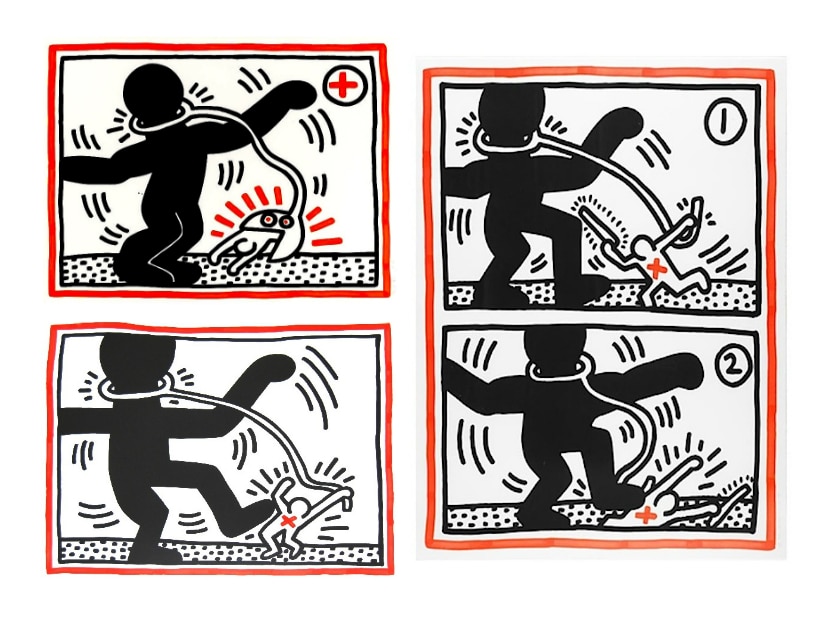
Free South Africa (Set of 3 prints), 1985
Free South Africa (Set of 3 prints), 1985
in
cm
$250,000
plus shipping & taxes
About the work
An homage to the struggle of black South Africans against the oppressive practices of the white minority in Apartheid South Africa, Keith Haring’s set of large-scale of lithographs is undeniably impactful. Rarely available as a complete set, the narrative suite depicts inequality and abuse symbolized by the rope or collar around the neck of a large black figure. Both forms are depicted in Haring’s iconic cartoon-like Pop style – the black figure captured by a small white figure. Haring’s signature motion lines surrounding each character clearly indicate the energetic fight taking place, one in which it appears the looming figure finally overtakes their oppressor. Haring distributed thousands of similar posters around New York City in 1986 to help mobilize support against Apartheid.
This is a matching number set of 3 prints and must be sold together. Each print measure 32 x 40 inches and is signed, dated, and numbered.
From top left, counter clockwise:
Free South Africa #1
Free South Africa #2
Free South Africa #3
Keith Haring
Keith Haring, born on May 4, 1958, in Reading, Pennsylvania, developed a passion for drawing at an early age. He learned the basics of cartooning from his father and drew inspiration from popular culture figures like Dr. Seuss and Walt Disney. After graduating high school, Haring moved to New York City and enrolled in the School of Visual Arts.
In New York, Haring became part of a thriving alternative art scene that flourished outside traditional galleries and museums. This community of artists, musicians, performers, and graffiti writers worked in unconventional spaces like subways, clubs, and former dance halls. During this time, Haring befriended artists such as Kenny Scharf and Jean-Michel Basquiat. Immersed in the energy of this creative environment, Haring began showcasing his work at venues like Club 57 and developed a distinct style centred on the primacy of line.
In 1980, Haring discovered an innovative way to reach a wider audience when he noticed unused advertising panels covered in matte black paper in subway stations. Using white chalk, he transformed these blank surfaces into spaces for his drawings. Over the next five years, he created hundreds of these “subway drawings,” sometimes producing as many as 40 in a single day. For Haring, the subway became a “laboratory” where he refined his ideas and experimented with his bold, rhythmic lines. Commuters often paused to watch and interact with him as he worked, making his art a part of New York City’s daily life.
From 1980 to 1986, Haring gained international acclaim, participating in numerous group and solo exhibitions. His first solo show, held at the Tony Shafrazi Gallery in New York in 1982, was both a critical and popular success. During this period, Haring’s work was included in prestigious international exhibitions, such as Documenta 7 in Kassel, Germany, the São Paulo Biennial, and the Whitney Biennial. He also completed several public projects, with many created for charities, hospitals, and children’s centres, reflecting his commitment to community-oriented work.
Public art became a significant focus of Haring’s career. Between 1982 and 1989, he produced more than 50 public works in cities worldwide, often incorporating social messages. Haring used his art to advocate for causes and to bring attention to critical issues, including children’s welfare and AIDS awareness.
In 1988, Haring was diagnosed with AIDS. During the final years of his life, he used his imagery to address his illness and promote activism and awareness around the AIDS epidemic. Despite his brief but prolific career during the 1980s, Haring participated in over 100 solo and group exhibitions. His work addressed universal themes like birth, death, love, sex, and war, with a simplicity of line and directness of message that made his imagery accessible and enduring. Haring’s visual language has since become one of the most recognisable of the 20th century.
Keith Haring passed away from AIDS-related complications on February 16, 1990, at the age of 31. His legacy lives on through international retrospectives and the continued presence of his work in major museums around the world.
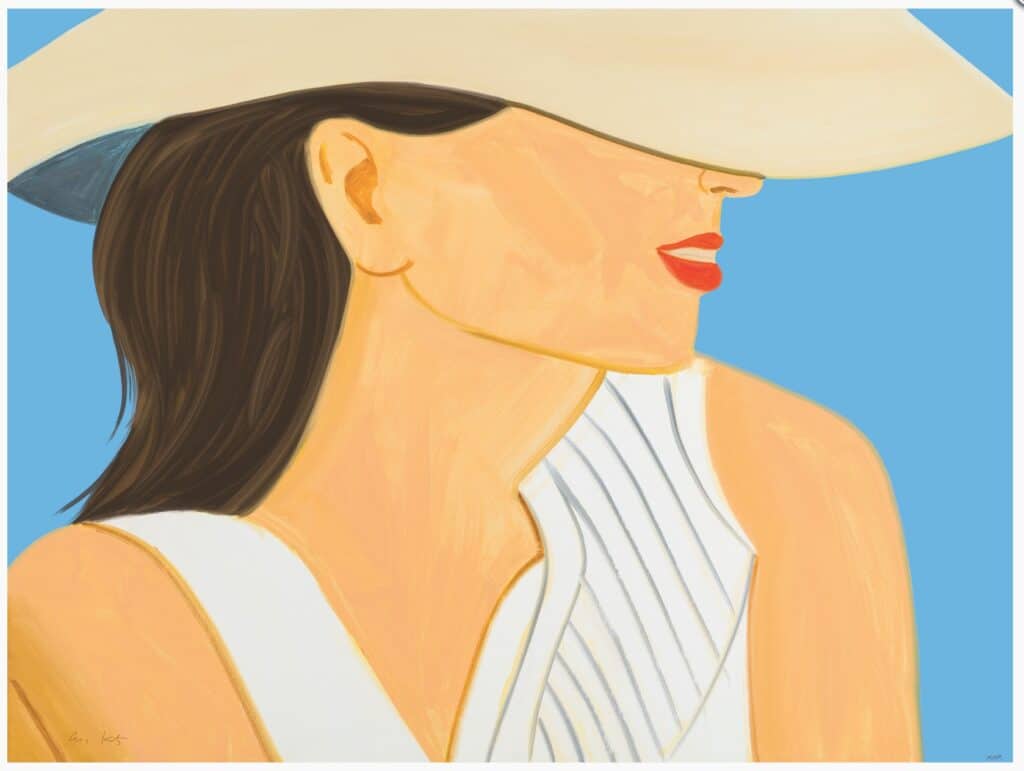
Vivien with Hat, 2021
Vivien with Hat, 2021
in
cm
$78,000
plus shipping & taxes
About the work
In this image, Vivien with Hat, Alex Katz presents the viewer with a deceptively simple portrait of a woman, rendered in profile, wearing a large, wide-brimmed sun hat that hides her eyes. A flat blue background maintains focus on the stylishly attired subject, whose bold red lips add colour and some slight insight into her personality. In line with Katz’s common minimalist approach, Vivien with Hat features clean lines and simple forms, but the artist’s gentle hand somehow enhances, rather than detracts from, the character’s presence. A tilted shoulder, a glimpse of a stylish white top, and a slight smile all ensure the woman evocatively resonates with the viewer.
Pencil signed and numbered.
Alex Katz
Alex Katz is an American painter known for his distinctive portraits and landscapes. Throughout his career, he has deliberately avoided the dominant non-figurative styles of his early years. Based in New York City since the 1950s, Katz spends his summers in Maine, a region that has inspired many of his renowned landscape paintings. His portraits, on the other hand, depict people from his personal and professional life, including colleagues, family, friends, and neighbours.
Katz’s portraits are instantly recognisable, defined by their characteristic flatness and simplicity. Shadows and light are represented with subtle variations in colour, while monochrome backgrounds frequently frame his subjects, further reinforcing his unique style. The lack of intricate detail and sharp lines creates a visual language that is both minimalist and striking.
These portraits are not intended to convey a clear narrative or personal story. Katz focuses instead on celebrating the beauty of his subjects, often highlighting fashion details and using soft, harmonious colours. The warmth of his works emerges from this combination, tempering their flatness and lack of detail to create paintings that are both elegant and inviting.
Katz has achieved widespread acclaim, influencing younger figurative artists such as Elizabeth Peyton and Julian Opie. Although his work predates the Pop Art movement, its engagement with mid-century culture, including television and advertising, draws comparisons to Pop Art aesthetics.
One of Katz’s greatest stylistic influences is the Japanese woodblock artist Kitagawa Utamaro (1753–1806), a master of the Ukiyo-e tradition. Known for capturing everyday scenes and portraits of beautiful women, Utamaro’s work is characterised by its flat, two-dimensional quality, partial views, and emphasis on light and shade. Katz’s use of these elements reflects Utamaro’s influence, adapting them into his own modern aesthetic.
Alex Katz’s art is featured in over 100 public collections worldwide. Following significant retrospectives at the Whitney Museum of American Art in 1986 and the Brooklyn Museum of Art in 1988, Katz’s work has been showcased in major exhibitions across the United States and Europe. He continues to spend his summers in Lincolnville, Maine, where the natural landscape remains a central source of inspiration for his art.
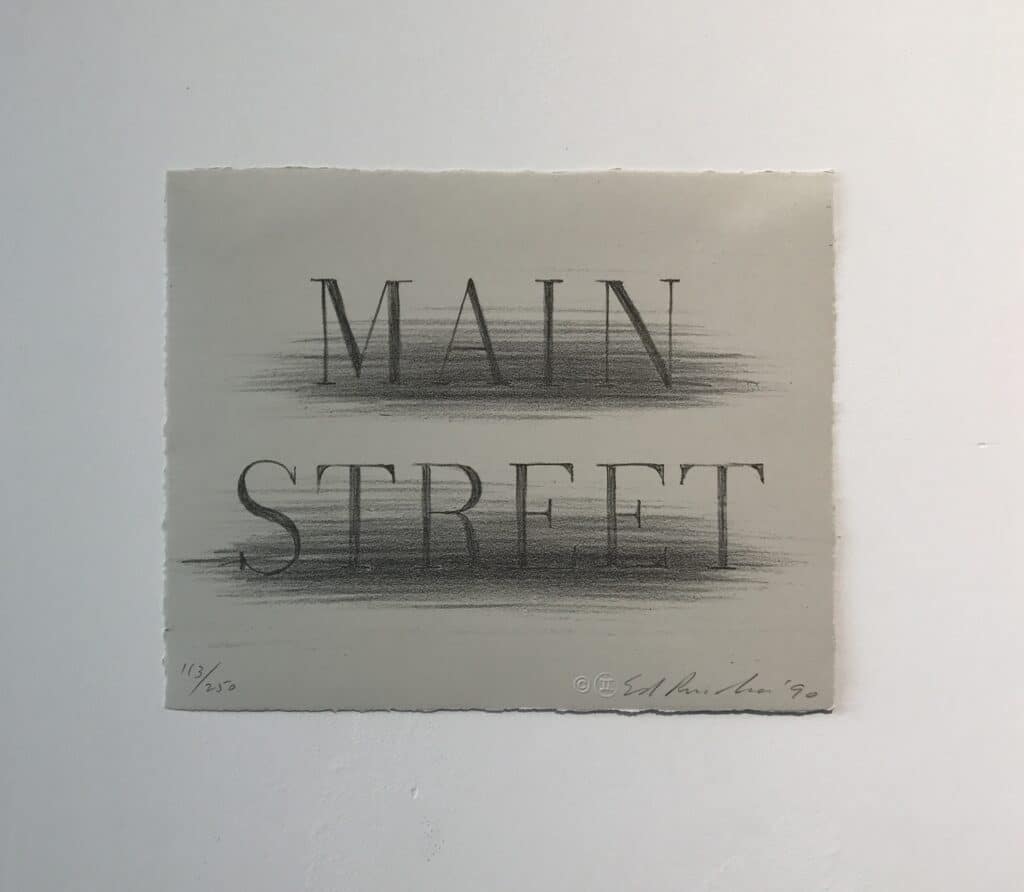
Main Street, 1990
Main Street, 1990
in
cm
$12,500
plus shipping & taxes
About the work
Main Street is a potent example of Ed Ruscha’s fascination with language and his ability to transform the mundane. More than 10,000 municipalities in the United States have a “Main Street,” a fact that both removes the uniqueness and underlines the significance of Ruscha’s chosen words. His use of a familiar street sign typography renders this image immediately recognizable, though the viewer is left to imagine all other identifying features, from the perimeters of the signage to the bustling commercial throughway behind. Greyscale minimalism invites us all to imagine our hometown’s Main Street, or one from a favoured memory, imbuing the print with each viewer’s own, individualized meaning.
Pencil signed, dated, and numbered.
Ed Ruscha
Edward Ruscha has played a significant role in American art since the 1960s, when his work first gained prominence as part of the West Coast Pop Art movement. Over time, he developed a unique style that integrates words and images within a single composition, creating a dynamic interaction between visual and verbal elements. The words in his art often evoke mental images that challenge or contrast with the visual content, adding layers of meaning.
Born in Omaha, Nebraska, in 1937, Ruscha spent his formative years in Oklahoma City before relocating to Los Angeles, where he studied at the Chouinard Art Institute from 1956 to 1960. By the early 1960s, he had made a name for himself with his paintings, collages, and prints, as well as his affiliation with the Ferus Gallery group. This collective included other notable artists such as Robert Irwin, Edward Moses, Ken Price, and Edward Kienholz. Ruscha became widely recognized for his use of text in paintings and for his innovative photographic books, all reflecting the playful irreverence of Pop Art.
Ruscha’s ability to transform the mundane into something meaningful sets his work apart. He often reduces his subjects to their bare essentials, with places and structures appearing as simple shadows. His fascination with language drives much of his art, as he explores how words can suggest meaning without depicting it visually. Text frequently dominates his canvases, clear in presentation but deliberately ambiguous in interpretation.
In 2000, the Hirshhorn Museum and Sculpture Garden in Washington, D.C., held a major retrospective of Ruscha’s work, which later toured the Museum of Contemporary Art in Chicago, the Miami Art Museum, and the Modern Art Museum of Fort Worth. The following year, he was elected to the American Academy of Arts and Letters. Over his decades-long career, Ruscha’s work has been exhibited internationally and is part of major museum collections worldwide. His public commissions include murals for the Miami-Dade Public Library (1985 and 1989) and the Great Hall of the Denver Central Library (1994–95). He is represented by Gagosian Gallery in Los Angeles and Leo Castelli Gallery in New York. In 2004, the Whitney Museum of American Art held a retrospective of his drawings titled Cotton Puffs, Q-tips®, Smoke and Mirrors: The Drawings of Ed Ruscha.
In 2005, Ruscha was chosen to represent the United States at the Venice Biennale, following recommendations from curators and directors of prominent American museums, including the Guggenheim Museum, the Hirshhorn Museum, the San Francisco Museum of Modern Art, and the Whitney Museum. He selected Linda Norden, Associate Curator of Contemporary Art at the Fogg Art Museum at Harvard University, to curate the exhibition, a decision approved by the U.S. Department of State.
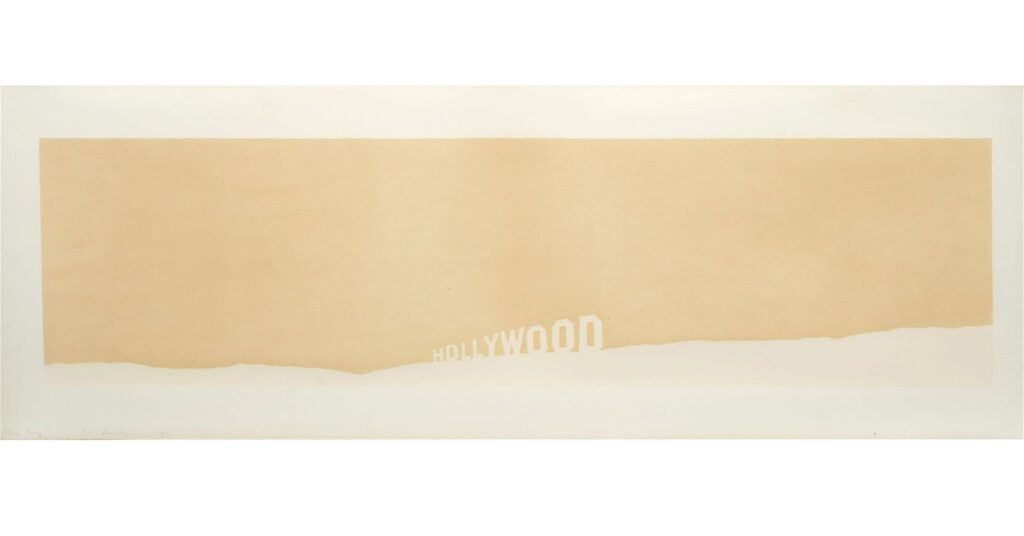
Hollywood Fruit-Metrecal, 1971
Hollywood Fruit-Metrecal, 1971
in
cm
$122,000
plus shipping & taxes
About the work
American artist Ed Ruscha created his iconic Hollywood series using some of the unconventional mediums he began to favour in the 1970s: fruit jams and the diet drink Metrecal. The result is a soft, almost pastel background against which the famous Hollywood sign stands out, though the iconic visual is removed from its usual scrub brush hills and other Californian flora. Stretching nearly four feet across, the print envelops the viewer’s peripheral, offsetting the minimalism of the visual with the vastness of the implied skyline.
Artist’s proof. Pencil signed, dated, and numbered.
Ed Ruscha
Edward Ruscha has played a significant role in American art since the 1960s, when his work first gained prominence as part of the West Coast Pop Art movement. Over time, he developed a unique style that integrates words and images within a single composition, creating a dynamic interaction between visual and verbal elements. The words in his art often evoke mental images that challenge or contrast with the visual content, adding layers of meaning.
Born in Omaha, Nebraska, in 1937, Ruscha spent his formative years in Oklahoma City before relocating to Los Angeles, where he studied at the Chouinard Art Institute from 1956 to 1960. By the early 1960s, he had made a name for himself with his paintings, collages, and prints, as well as his affiliation with the Ferus Gallery group. This collective included other notable artists such as Robert Irwin, Edward Moses, Ken Price, and Edward Kienholz. Ruscha became widely recognized for his use of text in paintings and for his innovative photographic books, all reflecting the playful irreverence of Pop Art.
Ruscha’s ability to transform the mundane into something meaningful sets his work apart. He often reduces his subjects to their bare essentials, with places and structures appearing as simple shadows. His fascination with language drives much of his art, as he explores how words can suggest meaning without depicting it visually. Text frequently dominates his canvases, clear in presentation but deliberately ambiguous in interpretation.
In 2000, the Hirshhorn Museum and Sculpture Garden in Washington, D.C., held a major retrospective of Ruscha’s work, which later toured the Museum of Contemporary Art in Chicago, the Miami Art Museum, and the Modern Art Museum of Fort Worth. The following year, he was elected to the American Academy of Arts and Letters. Over his decades-long career, Ruscha’s work has been exhibited internationally and is part of major museum collections worldwide. His public commissions include murals for the Miami-Dade Public Library (1985 and 1989) and the Great Hall of the Denver Central Library (1994–95). He is represented by Gagosian Gallery in Los Angeles and Leo Castelli Gallery in New York. In 2004, the Whitney Museum of American Art held a retrospective of his drawings titled Cotton Puffs, Q-tips®, Smoke and Mirrors: The Drawings of Ed Ruscha.
In 2005, Ruscha was chosen to represent the United States at the Venice Biennale, following recommendations from curators and directors of prominent American museums, including the Guggenheim Museum, the Hirshhorn Museum, the San Francisco Museum of Modern Art, and the Whitney Museum. He selected Linda Norden, Associate Curator of Contemporary Art at the Fogg Art Museum at Harvard University, to curate the exhibition, a decision approved by the U.S. Department of State.

$ Dollar Sign (F&S II.277), 1982
$ Dollar Sign (F&S II.277), 1982
in
cm
$165,000
plus shipping & taxes
About the work
Started in 1981, Warhol’s Dollar Sign series is a literal interpretation of the artist’s ongoing exploration of how art and commerce intertwine. Textured by overlaying multiple silkscreens, this particular series (F&S II. 277) consists of 60 unique prints that evoke sketchpad doodles but in large scale, super-sizing a notation that is usually seen in mere 12-point font. Here, gradations of bold purple act as the background for bright green scribbles over saturated gold, black, and blue. As with much of Warhol’s work, Dollar Sign takes the temperature of American culture and criticizes it at the same time, in a similar vein to his Campbell’s Soup Cans and his other ubiquitous images that both fetishize and subvert mass production and consumption.
Each print in this series is unique; signed and numbered in pencil.
Andy Warhol
Andy Warhol remains one of the most enigmatic and transformative figures in American art. His work became a defining expression of a culture preoccupied with images, fame, and consumerism. Surrounded by a colourful entourage of bohemians with names like Viva, Candy Darling, and Ultra Violet, Warhol’s social life was legendary and he was also recognized for his unrelenting work ethic. His art blurred the lines between high and low culture, while his films became milestones in experimental art and the evolution of contemporary art films. In his later years, Warhol was often seen wandering New York’s affluent neighbourhoods with a plastic bag full of hundred-dollar bills, buying jewellery and trinkets. Andy Warhol forever changed the way the world views art.
Born Andrew Warhola on August 6, 1928, in Pittsburgh, Warhol studied at the Carnegie Institute of Technology, earning his B.F.A. in 1949. That same year, he moved to New York City, where he quickly gained success as a commercial artist and illustrator. Throughout the 1950s, his drawings were featured in Glamour and other magazines, as well as department store displays. He became especially well-known for his illustrations of I. Miller shoes. In 1952, the Hugo Gallery in New York exhibited his illustrations for Truman Capote’s writings, further establishing his reputation.
During this period, Warhol also began exploring a separate body of work that he considered his serious artistic pursuit. While these paintings maintained stylistic elements of advertising, they sought to do the opposite of selling. His iconic series of Campbell’s Soup Cans, along with works featuring Coca-Cola bottles, Superman comics, and other familiar images, examined society’s fixation on consumer goods. Unlike advertisements, which aimed to evoke unconscious desire, Warhol’s art invited viewers to pause and reflect on the oversaturated imagery surrounding them. This approach aligned him with other artists of the Pop Art movement, such as Jasper Johns, Roy Lichtenstein, and Robert Rauschenberg.
In the late 1950s and throughout the 1960s, Warhol worked at an astonishing pace, adopting production methods that mirrored the industries he critiqued. He dubbed his studio “The Factory,” which became both a hub for creating paintings, silkscreens, and sculptures, and a gathering place for New York’s vibrant cultural elite. Frequent visitors included Mick Jagger, Lou Reed, Martha Graham, and Truman Capote. Warhol’s fascination with fame, youth, and personality transformed him into a cultural icon in his own right, reflecting the desires of a consumer-driven American society. His famous observation that “everyone will be world-famous for fifteen minutes” captured the growing commodification of everyday life with striking accuracy.
By the mid-1960s, Warhol was one of the most renowned artists in the world. Critics often struggled to interpret his groundbreaking work, which aimed to make viewers linger on images longer than they ordinarily would. In the 1970s and 1980s, Warhol created hundreds of silkscreen portraits, depicting figures such as Liza Minnelli, Jimmy Carter, Elizabeth Taylor, and Albert Einstein. These works revealed a more nuanced and expressionistic side of his artistry.
Andy Warhol passed away on February 22, 1987. His legacy endures as a cornerstone of contemporary art, reshaping how we understand fame, consumerism, and the role of art in modern society.